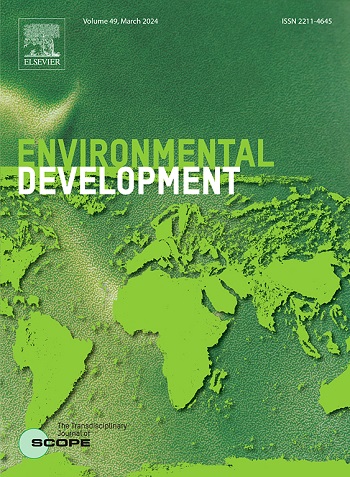Identifying the relative importance of cultivating medicinal plants in improving rural livelihoods
IF 4.7
2区 环境科学与生态学
Q2 ENVIRONMENTAL SCIENCES
引用次数: 0
Abstract
The agricultural sector and its related industries form the backbone of many economies, particularly in developing countries. Among the vital sub-sectors of agriculture, medicinal plant cultivation has garnered significant attention. Iran, with its favorable climatic and geographical conditions, is home to a wide variety of medicinal plants. Medicinal plants hold significant strategic importance in sustainable development, contributing to economic growth, environmental conservation, public health improvement, employment generation, food security, and the preservation of genetic resources. This multifaceted role has enhanced their prominence at both national and global levels. Today, the deepening significance of medicinal plants, especially in pharmaceutical supply, marks them as a key development indicator worldwide. This study focuses on the relative importance of cultivating medicinal plants in improving rural livelihoods, a topic largely overlooked in prior research. The research tool’s validity and reliability were thoroughly assessed and confirmed. Regression analysis revealed that medicinal plant cultivation accounts for a 42% impact on rural livelihoods. The prioritization of these plants based on their contribution to livelihoods is as follows: 1) saffron, 2) barberry, 3) cumin, and 4) jujube. Given the significant role of medicinal plant cultivation in enhancing rural livelihoods and its potential for export in international markets, it is imperative to ensure their production adheres to scientific and legal standards. Furthermore, policies aimed at expanding and institutionalizing the processing and packaging of medicinal plants can play a critical role in reducing environmental pollution. To strengthen this sector, it is recommended to adopt advanced cultivation techniques, such as hydroponics, enhance transportation infrastructure, and promote the growth of startups in the medicinal plant industry through targeted financial and technical support. These strategies have the potential to significantly enhance rural economic opportunities while simultaneously promoting sustainable development and facilitating improved market access for medicinal plant products.
确定种植药用植物对改善农村生计的相对重要性
农业部门及其相关产业是许多经济体的支柱,特别是在发展中国家。在农业的重要子部门中,药用植物种植已引起了极大的关注。伊朗气候和地理条件优越,是各种药用植物的家园。药用植物在可持续发展中具有重要的战略意义,有助于经济增长、环境保护、改善公共卫生、创造就业、粮食安全以及保护遗传资源。这种多方面的作用增强了它们在国家和全球两级的突出地位。今天,药用植物的重要性日益加深,特别是在药物供应方面,标志着它们成为世界范围内重要的发展指标。本研究的重点是种植药用植物在改善农村生计方面的相对重要性,这是一个在以前的研究中很大程度上被忽视的话题。对研究工具的效度和信度进行了全面的评估和确认。回归分析显示,药用植物种植对农村生计的影响占42%。根据对生计的贡献,这些植物的优先顺序如下:1)藏红花,2)小檗,3)孜然,4)枣子。鉴于药用植物种植在改善农村生计方面的重要作用及其在国际市场上的出口潜力,必须确保其生产符合科学和法律标准。此外,旨在扩大药用植物的加工和包装并使其制度化的政策可在减少环境污染方面发挥关键作用。为加强这一领域,建议采用水培等先进栽培技术,加强交通基础设施,并通过有针对性的资金和技术支持促进药用植物行业初创企业的成长。这些战略有可能大大增加农村经济机会,同时促进可持续发展和促进改善药用植物产品的市场准入。
本文章由计算机程序翻译,如有差异,请以英文原文为准。
求助全文
约1分钟内获得全文
求助全文
来源期刊

Environmental Development
Social Sciences-Geography, Planning and Development
CiteScore
8.40
自引率
1.90%
发文量
62
审稿时长
74 days
期刊介绍:
Environmental Development provides a future oriented, pro-active, authoritative source of information and learning for researchers, postgraduate students, policymakers, and managers, and bridges the gap between fundamental research and the application in management and policy practices. It stimulates the exchange and coupling of traditional scientific knowledge on the environment, with the experiential knowledge among decision makers and other stakeholders and also connects natural sciences and social and behavioral sciences. Environmental Development includes and promotes scientific work from the non-western world, and also strengthens the collaboration between the developed and developing world. Further it links environmental research to broader issues of economic and social-cultural developments, and is intended to shorten the delays between research and publication, while ensuring thorough peer review. Environmental Development also creates a forum for transnational communication, discussion and global action.
Environmental Development is open to a broad range of disciplines and authors. The journal welcomes, in particular, contributions from a younger generation of researchers, and papers expanding the frontiers of environmental sciences, pointing at new directions and innovative answers.
All submissions to Environmental Development are reviewed using the general criteria of quality, originality, precision, importance of topic and insights, clarity of exposition, which are in keeping with the journal''s aims and scope.
 求助内容:
求助内容: 应助结果提醒方式:
应助结果提醒方式:


